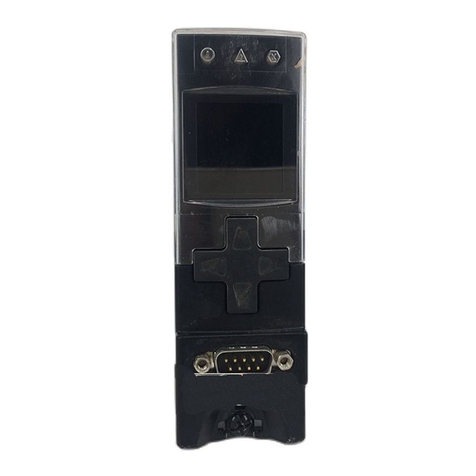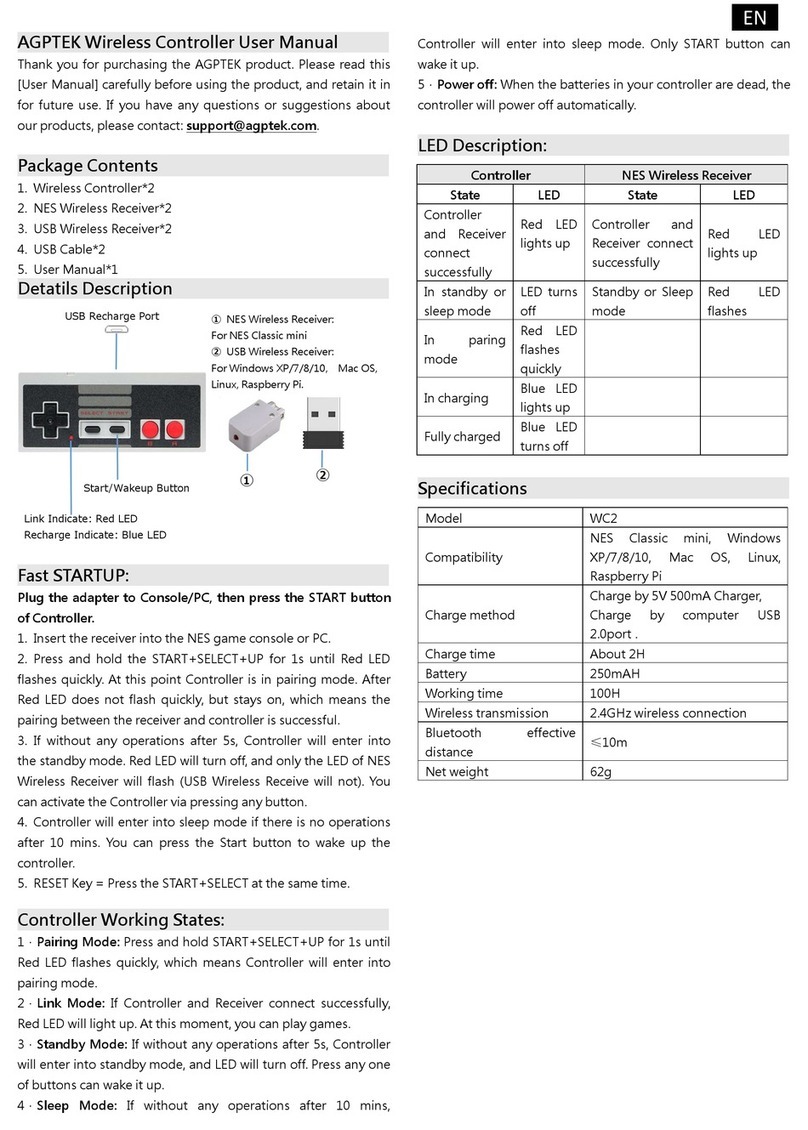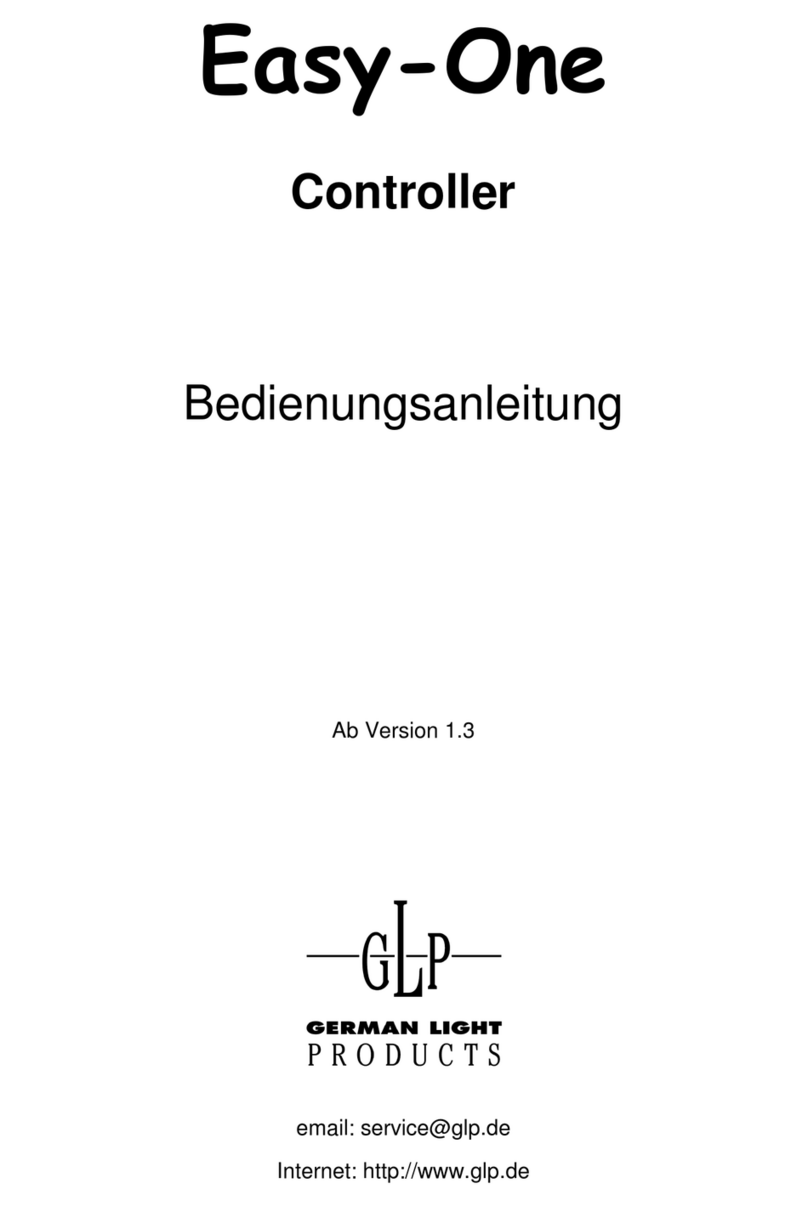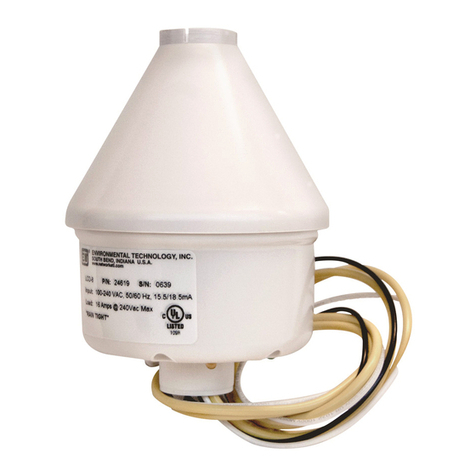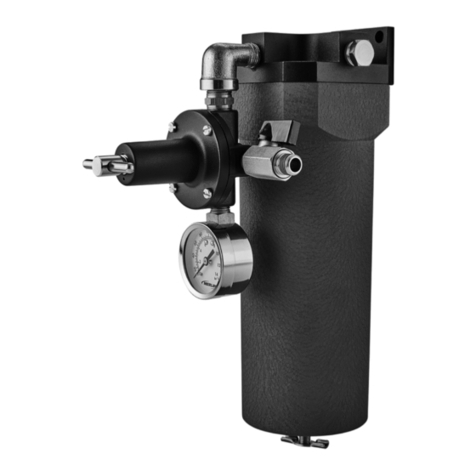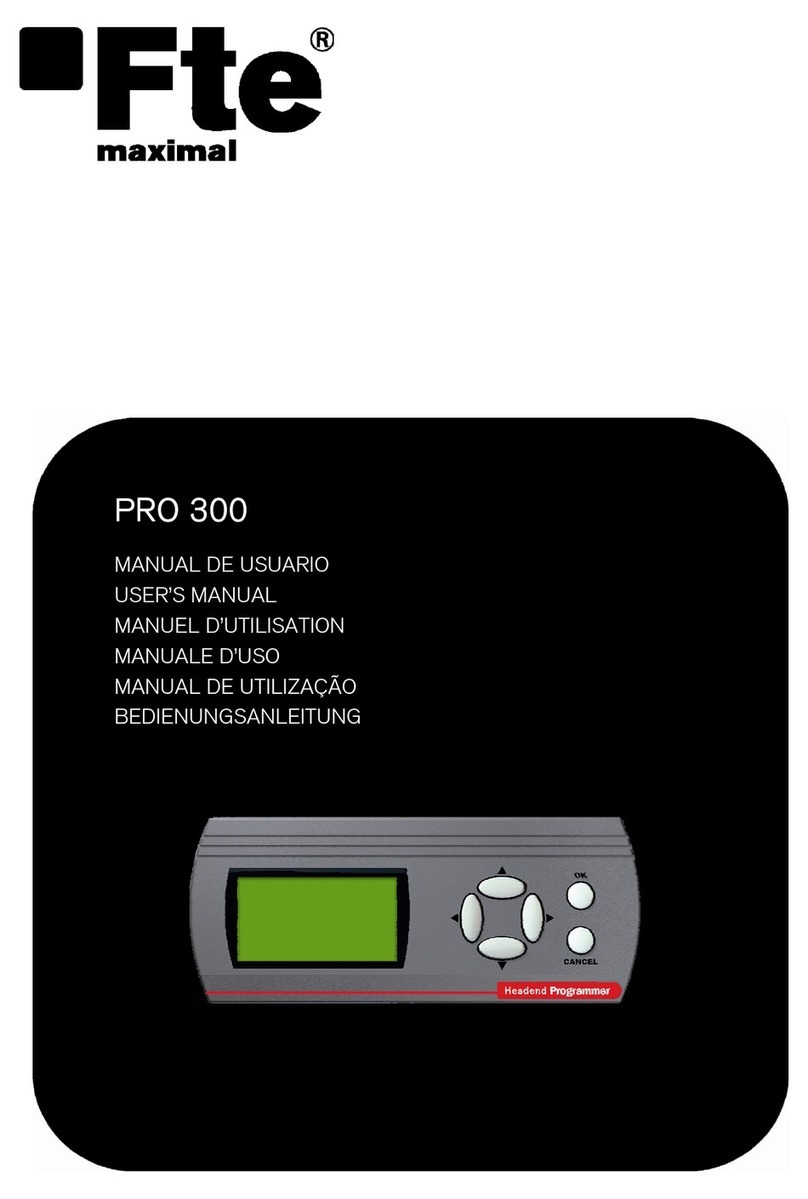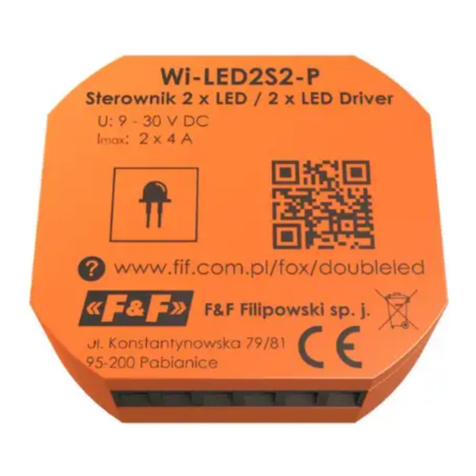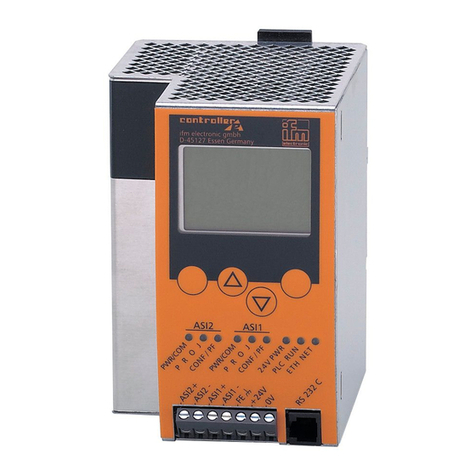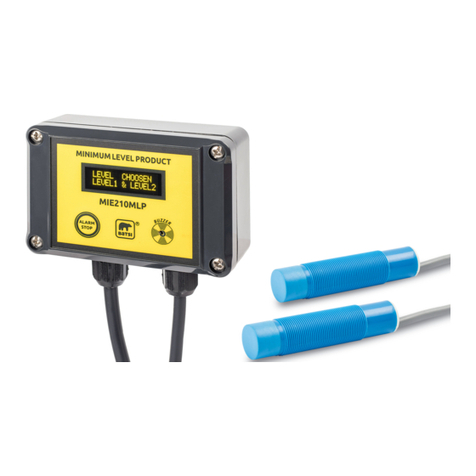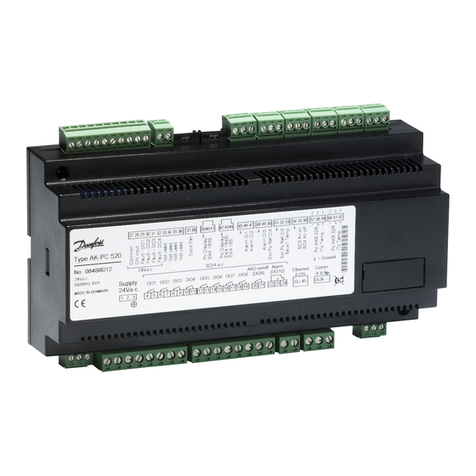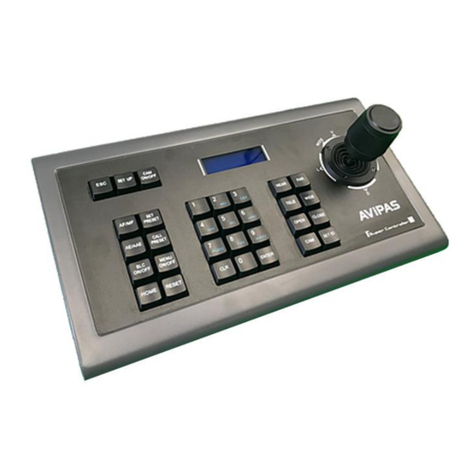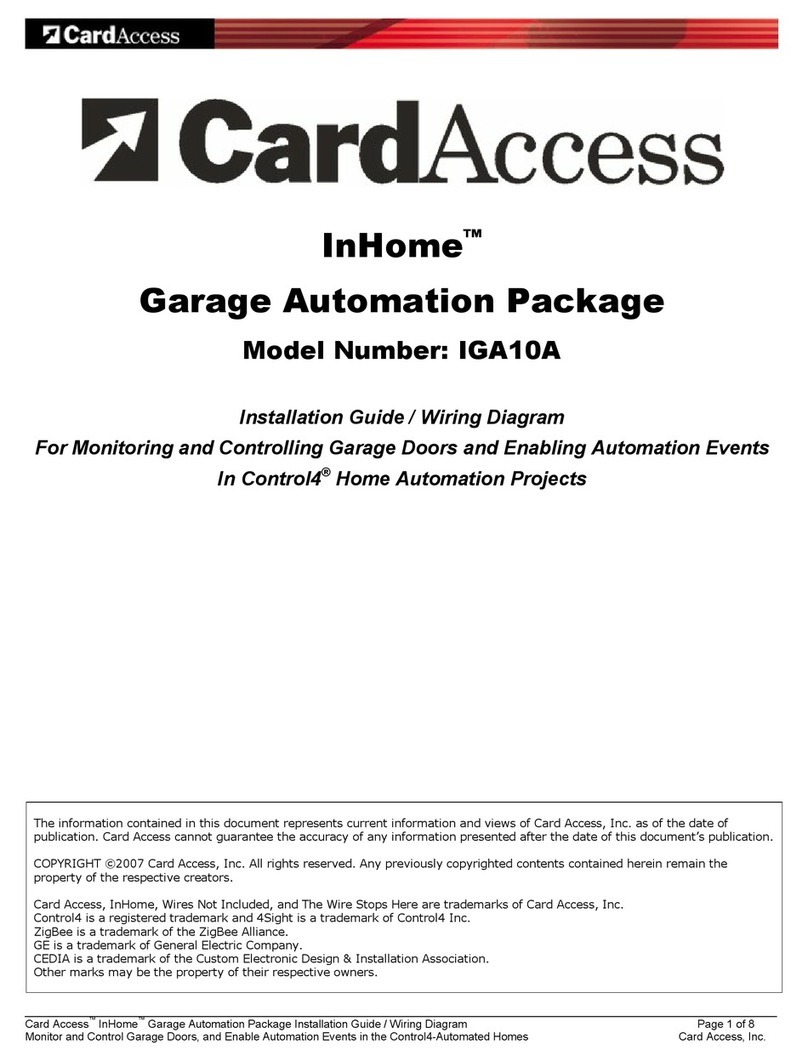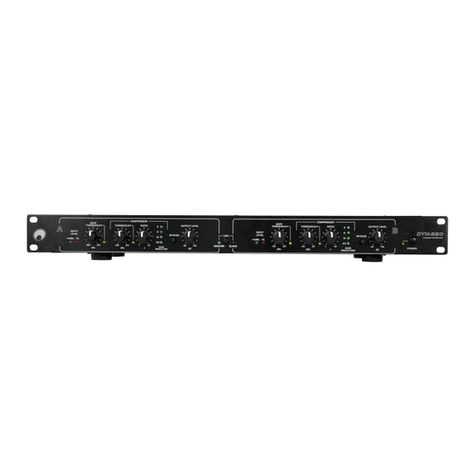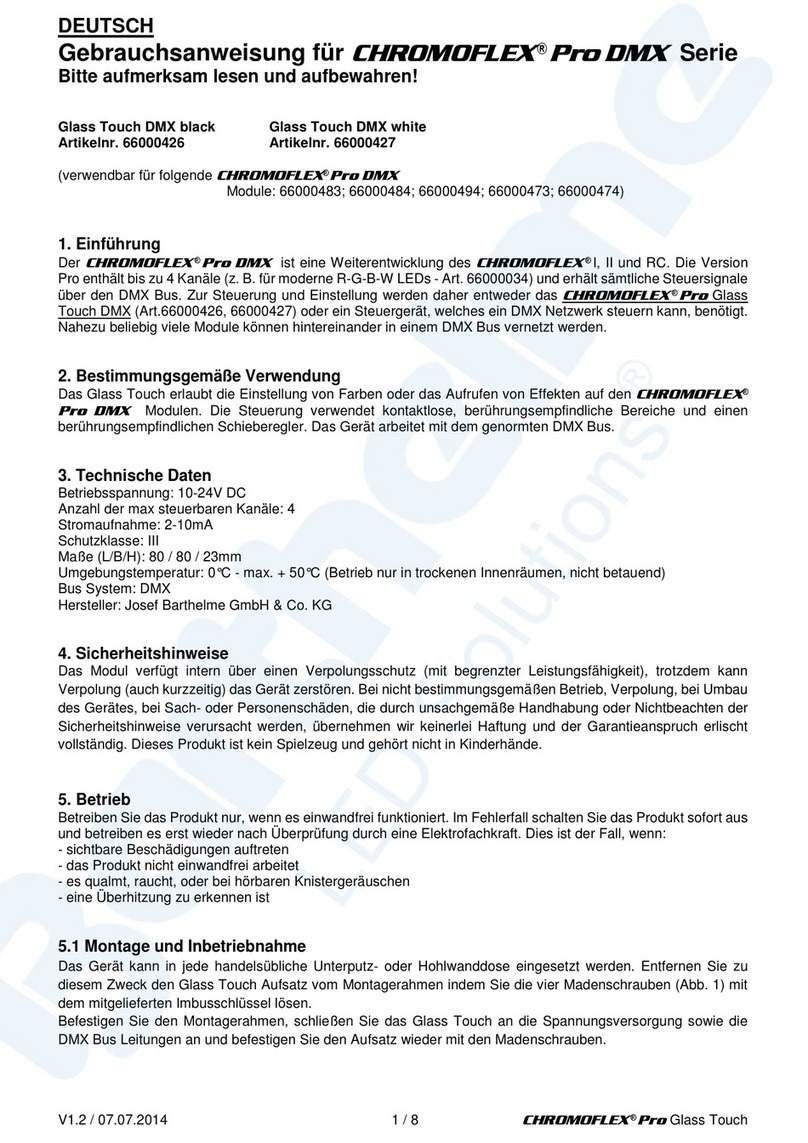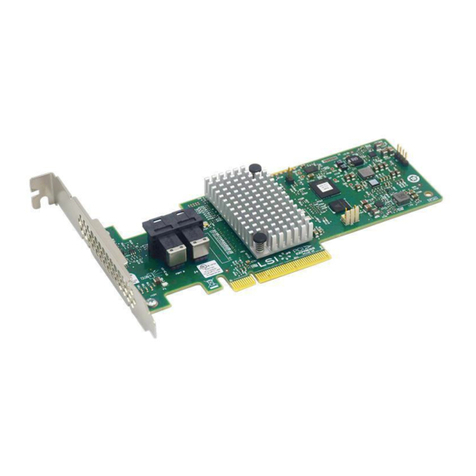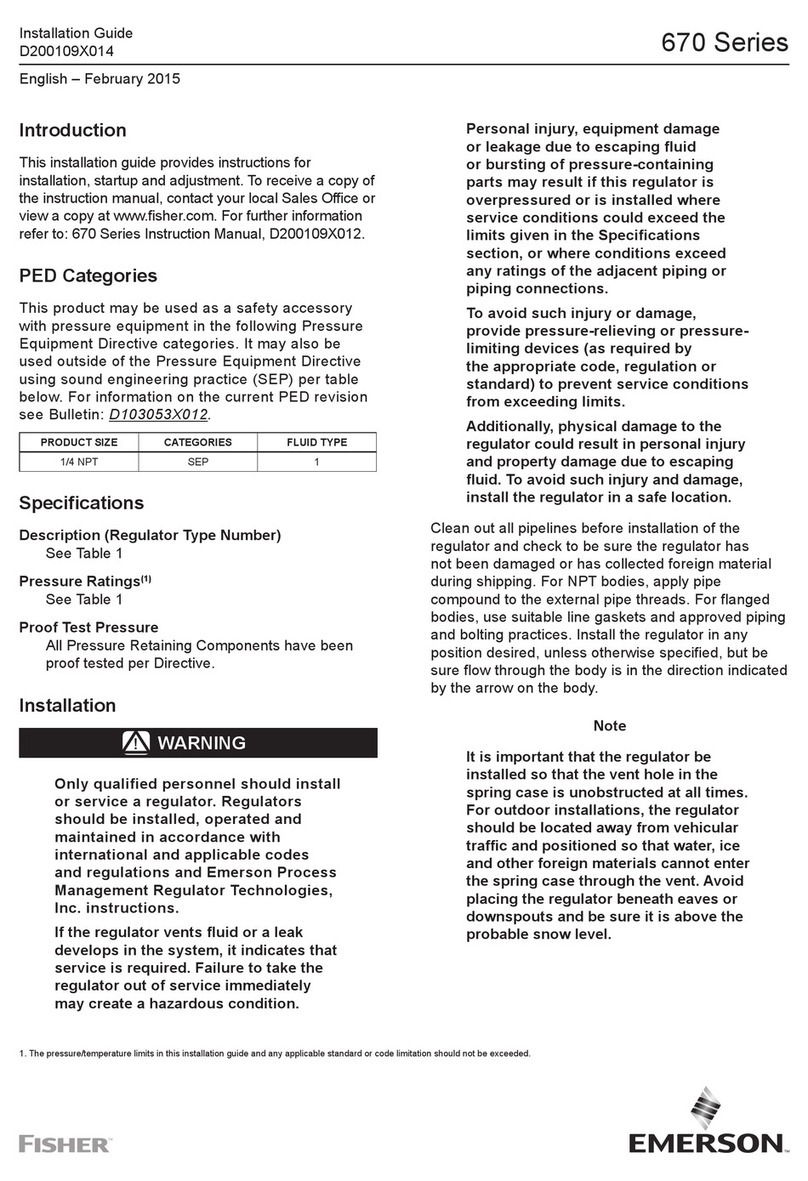Sporlan Superheat User manual

May 2020 / Bulletin 100-50-5.1
Superheat Control
Installation and Operation Instructions
Controller v. M.2

Page 2 – Bulletin 100-50-5.1
1. Installation .............................. 3
2. Setup.................................. 4
Superheat Control with Display .............. 4
Superheat Control without Display ............ 5
Factory Reset ........................... 5
3. Setpoint Menu Operation ................... 5
4. System Operation ........................ 5
Refrigeration ............................ 5
Chillers and Air Conditioners ................ 6
Control Features ......................... 6
System Parameters ....................... 7
5. Display Networking ....................... 9
Multiple Controllers ...................... 10
Junction Box Fabrication .................. 10
6. Controller Networking . . . . . . . . . . . . . . . . . . . . 10
Scaling. . . . . . . . . . . . . . . . . . . . . . . . . . . . . . . . 10
Setup. . . . . . . . . . . . . . . . . . . . . . . . . . . . . . . . . 11
RS-485 Connection Requirements. . . . . . . . . . . 11
7. PID Tuning ............................. 11
8. Troubleshooting ......................... 12
Troubleshooting Recommendations .......... 12
Sensors ............................... 12
Alarms ................................ 12
APPENDIX A
Setup Menu ............................ 15
APPENDIX B
Process Values ......................... 16
APPENDIX C
Setpoint Parameters ..................... 17
APPENDIX D
Accessories ............................ 19
APPENDIX E
Technical Specifications ................... 19
APPENDIX F
Controller Status ........................ 19
APPENDIX G
Miscellaneous Displays ................... 19
APPENDIX H
Wiring Diagram ......................... 20
APPENDIX I
Sensor Installation ....................... 21
APPENDIX J
MODBUS Memory Map ................... 22
APPENDIX K
BACnet Map ........................... 24
APPENDIX L
2K Temperature Sensor Specifications........ 32
APPENDIX M
3K Temperature Sensor Specifications........ 33
APPENDIX N
10K Temperature Sensor Specifications....... 34
Terms of Sale with Warranty Limitations......... 35
Contents
⚠WARNING – USER RESPONSIBILITY
Failure or improper selection or improper use of the products described herein or related items can cause death, personal injury and property damage.
This document and other information from Parker Hannifin Corporation, its subsidiaries and authorized distributors provide product or system options for further
investigation by users having technical expertise.
The user, through its own analysis and testing, is solely responsible for making the final selection of the system and components and assuring that all performance,
endurance, maintenance, safety and warning requirements of the application are met. The user must analyze all aspects of the application, follow applicable industry
standards, and follow the information concerning the product in the current product catalog and in any other materials provided from Parker or its subsidiaries or
authorized distributors.
To the extent that Parker or its subsidiaries or authorized distributors provide component or system options based upon data or specifications provided by the user,
the user is responsible for determining that such data and specifications are suitable and sufficient for all applications and reasonably foreseeable uses of the
components or systems.
For safety information see the Safety Guide at www.parker.com/safety or call 1-800-CParker.
OFFER OF SALE
The items described in this document are hereby offered for sale by Parker Hannifin Corporation, its subsidiaries or its authorized distributors. This offer and its
acceptance are governed by the provisions stated in the detailed “Offer of Sale” available at www.parker.com.
FOR USE ON REFRIGERATION and/or AIR CONDITIONING SYSTEMS ONLY
For more information about our products visit us at www.sporlan.com.
Bulletin 100-50-5.1, May 2020 supersedes Bulletin 100-50-5.1, August 2016 and all prior publications.

Introduction
The Sporlan Superheat Control is a standalone
controller for refrigeration and air conditioning sys-
tems. The controller operates an electronic expan-
sion valve to control superheat. It may also be used
to control room temperature. The controller may be
networked into a building automation system and
offers several communication protocols. It is avail-
able with or without display for aftermarket or OEM
use. A remote display unit is optional.
Features
• Superheat or room temperature control
• 4-digit LED display with easy to use input knob
• OEM version available without display
• Optional remote display unit
• Optional display networking between controllers
• BACnet or MODBUS communication protocols
• One bi-polar or uni-polar step motor driver
(30ohm/coil minimum)
• One mechanical relay output (for liquid line sole-
noid or piloting a compressor relay)
• Four temperature inputs (Sporlan surface or air
sensor)
• One pressure input (Sporlan pressure transducer)
• One digital input (for external switch or relay)
Bulletin 100-50-5.1 – Page 3
1. Installation
Refer to Appendix H - Wiring Diagram and Appendix I -
Sensor Installation
TOOLS REQUIRED:
• Small flat screwdriver for terminal connections
• Phillips and flat screwdrivers
• Cordless screwdriver
• Needle-nose pliers
• Wire cutters
• Scotch-BriteTM pad
• Two #8 x ½” self-tapping screws to mount DIN rail
1. Mount the controller in a rain-tight, protected location
using the supplied DIN Rail. To leave enough working
space, the suggested mounting area is 10 inches high
and 5 inches wide. The minimum depth is 3 inches. See
Figures 1 and 2.
Superheat Control
with display
Item Number 952567
Superheat Control
without display
Item Number 952569
Kelvin IId
Remote display unit
Item Number 952568
Figure 2 - DIN Rail Detail
1.5”
.25”
4.0”
3.25”
Figure 1 - Recommended Mounting Clearance

2. Connect the suction temperature sensor wires to ter-
minals 31 and 32. Sporlan temperature sensors are not
polarized.
3. Connect the pressure transducer wires to terminals 33,
34, and 35. Sporlan has used transducer cables with two
wire color combinations; see Table 1. Maximum torque
on screw terminals is 3.5 in-lbs.
4. Connect the optional room temperature sensor wires to
terminals 29 and 30. Sporlan temperature sensors are not
polarized.
5. Connect terminals 27 and 28 to a digital input. A short
or a closed contact from an external relay will close the
valve for pump down. See Section 4 - System Operation.
6. Connect the Sporlan EEV wires to terminals 5, 6, 7, and 8.
7. Connect power wires to terminals 1 and 2. Transformer
requirements are 24 volts AC/DC at 40 VA, Class II.
The Sporlan supplied DC power supply is 100-250
VAC/24 VDC, P/N 953444.
8.
NOTE: Sensor leads may be extended to 100 ft. (30.5 m)
with 18 awg wires and Scotchlok™ UR connectors for
long-term integrity. Belden wire is preferred; Transducer
Cable Belden 9493, Temperature Sensor Belden 9409.
WARNING: Route and secure cables away from
hot surfaces, high voltage lines, and moving
components.
NOTE: The Sporlan Superheat Control should be installed
only by a qualified professional. All other system compo-
nents (valves and sensors) should be supplied by Sporlan
to ensure compatibility and proper operation. There are
no user-serviceable components inside the Superheat
Control. Opening the case will void the warranty.
WARNING: Use caution when working around
high voltage components. Safety covers should be
used for personal safety on high voltage panels.
2. Setup
SUPERHEAT CONTROL WITH DISPLAY
The Superheat Control has preset setpoints for most system
parameters. Basic system parameters will be verified through
the setup menu. If additional parameter setpoints need to be
changed, follow the steps in this section and in Section 3 -
Setpoint Menu Operation.
Enter values for six system variables following the steps
below. Refer to Appendix A - Setup Menu. The EEV is closed
upon power-up and the system will not operate until complet-
ing setup. The controller will display the firmware versions
for the display and the controller. It will then display the first
variable to set.
CONTROLLER
TERMINAL
OLD PIGTAIL
LEADS
NEW HERMETIC
CABLE
+5VDC 35 Red Black
Signal 33 Green White
Ground 34 Black Green
Table 1 - Pressure Transducer Wire Colors
Page 4 – Bulletin 100-50-5.1
1. Set StEP, Step Motor Stroke. Press and then turn the
SELECT knob to select the correct number of steps for
the EEV being used. See Table 2 for a list of Sporlan
EEVs. Default is 2500. Press the SELECT knob again to
save the value. The next variable is displayed.
2. Set reFr, Refrigerant. Select the actual refrigerant used
in the system, following the steps above. Default is
R-404A.
NOTE: Verify the actual refrigerant used in the system.
3. Set tt4P, Temperature Sensor Type. Select 2K, 3K, 10K
or 98.6K; see pictures below. Default is 2K.
4. Set Pt4P, Pressure Sensor Type. Select Absolute or
Gauge (sealed), following the steps above. Default is
Gauge.
5. Set Un_t, Temperature Units. Select Fahrenheit or
Celsius. Default is Fahrenheit.
6. Set Un_p, Pressure Units. Select PSI or Bar. Default is
PSI.
Setup is now complete. The Superheat Control will begin
controlling superheat, and will display SvpH. The controller
is now in the Process Values Menu (Appendix B). Rotate the
SELECT knob to view the values.
Table 2 - Electric Expansion Valves
SPORLAN MODEL NUMBERS STEPS
SEI-.5, SEI-1, SER-1.5, SEI-2, SEI-3.5, SEI-6,
SER-6, SEI-11, SER-11, SER-20 1596
SER-AA, A, B, C, D, F, G, J, K, L 2500
SEI-30 3193
SEI-50, SEH-100, SEH-175 6386
ESX, OEV, SEV, SEV-C and CEV 500
3K Surface Sensor
2K Air, Surface
or Well Sensor
10K Air Sensor
(Green orYellow)
3K Air Sensor
(Black)
10K Surface Sensor
(Blue, Orange, or Red)
98.6K Surface Sensor

Bulletin 100-50-5.1 – Page 5
NOTE: Not all refrigeration systems are designed alike.
See Section 7 - PID Tuning to adjust the settings accord-
ing to the specific needs of the system.
SUPERHEAT CONTROL WITHOUT DISPLAY
To set up a Superheat Control without display that is con-
nected to either a Kelvin IId(remote display unit) or a
Superheat Control with display, first go to Section 5 -
Display Networking to establish a network connection.
Then follow the directions in this section and in Section 3 -
Setpoint Menu Operation.
FACTORY RESET
It may be desired to set all of the setpoints of the control
back to the factory defaults. Should that need arise, the user
can perform this function by doing the following steps:
1. With the controller powered off, press and hold the knob
on the display.
2. Power on the controller while the knob is still depressed.
3. The knob may be released once “FrSt” is seen on the
screen.
The controller will now require the user to complete the
setup process before continuing.
3. Setpoint Menu Operation
See Appendix C - Setpoint Parameters. All setpoints must be
verified prior to system startup for proper system operation.
It may be necessary to adjust these parameters for a specific
system. Details on advanced features can be reviewed in
Section 4 - System Operation.
1. To enter the Setpoint Menu: Press the SELECT knob
for 5 seconds. Enter the password “111 ” and press the
SELECT knob again.
2. To view a parameter, rotate the SELECT knob to the
desired parameter and press the knob. The default value
will display.
3. Turn the SELECT knob to change the value and then
press the SELECT knob to enter the value and return to
the Setpoint Menu.
4. After all desired parameters are set, turn the SELECT
knob to “ESC” and press the knob to save and implement
all changes. Observe the system for proper operation.
NOTE: The Setpoint Menu times out after 60 seconds of
inactivity and you will lose all changes entered.
The Superheat Control is now operational and displaying the
Process Values Menu (Appendix B). To view system param-
eters while in operation, turn the SELECT knob and scroll
through the menu. Select the desired parameter. For example,
to view system superheat, turn the SELECT knob to SvPH.
After a few seconds, the actual system superheat will be dis-
played. See Appendix B – Process Values for a description of
each variable.
Pressing the SELECT knob at any time will display the
Controller Display Address CAdr.
4. System Operation
The Sporlan Superheat Control can be configured as a stand-
alone superheat controller or a refrigerated space tempera-
ture controller. The controller can be used in refrigeration
systems, chillers, or air conditioning systems. The Superheat
Control should not be used inside of a conditioned space that
exceeds product specifications (See Appendix E - Technical
Specifications).
The controller, by default, is designed to control superheat
in refrigerated spaces that use evaporator pressure regula-
tors (EPRs). In all applications, it is recommended to use a
normally closed solenoid valve upstream of the electronic
expansion valve to ensure positive shutoff of refrigerant flow
during power loss.
REFRIGERATION
Superheat control on cases with EEPR (pre-
ferred method): The Superheat Control will regulate
the refrigerant flow entering the evaporator to achieve the
superheat setpoint. The EEPR is typically controlled by a
system level controller and provides consistent evaporator
temperatures based on the discharge air setpoint (set through
the system controller). This combination provides greater sta-
bility in control, increased efficiency of the evaporator coil,
and accurate case temperatures.
Superheat control on cases with liquid line sole-
noid or suction stop solenoid valves:
Some applications in refrigeration that typically use mechani-
cal expansion valves also use a solenoid valve upstream
(liquid line) or downstream (suction stop) of the TEV to
control case temperature. The system controller closes and
opens the solenoid valve to meet cut-in and cut-out tempera-
tures. If the Superheat Control is used on these systems in
conjunction with an EEV, a digital input must be connected
to the Auxiliary Temperature Sensor terminals (27 and 28 in
Appendix H – Wiring Diagram). Since refrigerant flow is a
critical part of the Superheat Control scheme, the controller
must be tied into the liquid line solenoid or suction stop sole-
noid when flow is stopped. This input allows the controller to
respond to major flow variations upstream or downstream of
the EEV.
Case temperature control using cut-in / cut-out:
The Superheat Control can be used as a thermostat by con-
necting a room temperature sensor to T2, terminals 29 and 30,
and setting C_n and Cvt to the desired cut-in and cut-out
temperatures, respectively. For optimum control, the room
sensor must be located inside the case as specied by the
refrigerated case manufacturer. Connect a normally closed
liquid line solenoid valve to terminals 19 and 20. The solenoid
valve should be wired so that the Superheat Control is cutting
one leg of the supply voltage. Terminals 19 and 20 may also
pilot a compressor relay in place of the liquid line solenoid on
smaller standalone systems. Note relay ratings specied in the
wiring diagram located in the appendix. The controller will
maximize the efciency of the evaporator coil by regulating

Page 6 – Bulletin 100-50-5.1
the EEV to control superheat until the cut-out temperature is
reached. The solenoid valve and EEV will then close until the
temperature rises to the cut-in temperature. Once the valves
close and refrigeration stops, the Superheat Control will
display FF. During refrigeration mode, the controller will
display C. During defrosts, the system master controller
must provide a digital input/short to terminals 27 and 28. The
Superheat Control will close the EEV and display pdn for
pumpdown. A standard dry contact relay can be used. A mini-
mum relay on and off time can be set for the solenoid valve.
See rnt and rF features under the Parameters Section.
CHILLERS AND AIR CONDITIONERS
Superheat control - Single evaporator:
The Superheat Control may be used on single evaporator
chillers or air conditioners. The default control scheme is
optimized for quick pull down (coil temperature) and stable
holding loads. If the controller is used on systems with major
transient conditions (impulse heat loads) it may be necessary
to adjust the PID control scheme parameters. See Section 7 -
PID Tuning.
Superheat control - Dual evaporator:
On some systems, it may be necessary to control two
independent evaporator coils. This setup will consist of a
Superheat Control with display and a Superheat Control
without display. A network must be established between the
two controllers; see Section 6 – Controller Networking. The
display can be used to set up both controllers and to review
parameters from each evaporator coil.
CONTROL FEATURES
Pumpdown
Closing or shorting terminals 27 and 28 (T3) places the con-
troller in pumpdown mode and closes the EEV. A standard
dry contact relay can be used. During pumpdown signal, the
Superheat Control will open terminals 19 and 20 (relay),
which can be used to pilot a solenoid valve or compressor.
During this time, the controller will shut down the control
scheme and prepare for restart. This ensures maximum con-
trol efficiency and system stability.
Manual Valve Positioning
The Superheat Control can be used to manually position the
EEV via a local or remote display. To access manual valve
control, navigate to the Setpoint menu, scroll to SPS and press
the SELECT knob. Once this is selected, the controller no
longer controls the superheat or case temperature setpoint. The
display will show the actual valve position, from 0% to 100%
open once the SELECT knob is pressed. To open the valve,
turn the select button clockwise. To close the valve, turn the
select button counter-clockwise. To end manual valve control,
press the SELECT knob to go back to the Setpoint menu. At
this point, the controller will resume normal operation.
The controller has an internal timeout function and after
60 minutes of inactivity, normal operation will resume. For
troubleshooting purposes, the timeout may be disabled us-
ing the Stepper Timeout Override (Stt) feature. This may
be accessed through the Setpoint menu and placed in the n
position to override the timeout. It should be noted that the
setpoint parameter menu must be exited before changes are
saved. The valve position shown under SPS will blink when
the timeout is disabled.
If manual valve control is needed without viewing system
parameters use the following steps:
1. Through the display, press and hold the SELECT knob
until E PASS appears.
2. Enter “111 ”by turning the knob.
3. Scroll to SPS feature and hold down the SELECT knob
until the position on the display starts blinking (10 sec-
onds). This will override the time out feature.
4. To move the valve, rotate the SELECT knob. The con-
troller will remain in manual mode until the SELECT
knob is pressed.
If manual valve control is needed while viewing system
parameters use the following steps:
1. Through the display, press and hold the SELECT knob
until E PASS appears.
2. Enter “111 ”by turning the knob.
3. Scroll to Stt feature and press SELECT knob.
4. Turn selection to .
5. Push the SELECT knob and scroll to ESC.
6. Press the SELECT knob; the controller is now locked in
manual mode.
7. To manually move the EEV press and hold the SELECT
knob until E PASS appears.
8. Enter “111 ”by turning the knob.
9. Scroll to Sp feature and press SELECT knob.
10. Rotate the knob to move the EEV. The position on the
display is shown % open and will be blinking while in
manual control.
11. To exit manual valve control, use the steps above and
select FF under Stt; exit parameter setpoint menu to
save changes and continue automatic control.
Manual valve control through MODBUS:
1. Enable the feature by writing a 1 to the “Manual Valve
Enabled” coil using the ‘Write Single Coil’ function. See
Appendix J – Modbus Memory Map.
2. Manually move the valve by writing the position, tenths
of a percent, to the “Manual Valve Position” holding reg-
ister using the ‘Write Single Register.’ Each time a write
is sent to the controller, the manual timeout feature resets.
Manual valve control through BACnet:
1. Enable the feature by writing a 1 to the “MANUAL_
VALVE_CONTROL” binary value object’s present value
property. See Appendix K – BACnet Map).
2. Manually move the valve by writing the position, in tenths
of a percent, to the “MANUAL_VALVE_POSITION” ana-
log value object’s present value property. Each time a write
is sent to the controller, the manual timeout feature resets.
NOTE: Use caution and monitor superheat while in manu-
al valve mode. To avoid floodback, start with the valve in a
low position. Never leave the system unattended while in
manual mode.

Bulletin 100-50-5.1 – Page 7
SYSTEM PARAMETERS
Addr (Address) – The MODBUS or BACnet network address
must be set on each Superheat Control if they will be installed
on a network. No two controllers may have the same address
on the network. The Superheat Control has been designed
to have addresses for both the controller and the display. It
should be noted that this parameter, Addr, is for the controller,
not the display.
vd (Baud Rate) – Baud rate refers to the number of signal
changes that occur per second via the communications line on
the network. The MODBUS or BACnet baud rate must be set
to the same rate as the master controller or other devices on
the network.
_S (Bleed Step Position) – The EEV will be placed in the
bleed position to allow for refrigerant equalization in the sys-
tem after the unit is signaled to shut down via a short across
terminals 27 and 28. The bleed position works in conjunction
with _d, bleed delay feature. The default bleed position is
0%. See below for more information.
_d (Bleed Delay) – The bleed delay feature works with
the _S, bleed step position feature. Once the system gets a
signal to shut down via a short across terminals 27 and 28, the
EEV will close to 0% then dwell for the bleed delay time, in
seconds, before moving to the bleed delay position for system
pressure equalization. The default bleed delay time is 0 sec-
onds. See below for more information.
Bleed System Equalization (_S, _d)
Use of an EEV can dramatically improve efciency of a re-
frigeration or air conditioning system. By accurately control-
ling the system’s superheat, the EEV achieves full utilization
of the evaporator coil surface area. A drawback to the use
of EEVs with some compressors is the need for off-cycle
pressure equalization of high to low system pressure. Speci-
cally, when the system is off the compressor is not cycling
refrigerant and the EEV is closed. This keeps refrigerant from
owing through the system. This condition can cause high
backpressure on the discharge side of the compressor, and
hence, a hard start condition. Setting a Bleed Step Position,
_S, allows a small amount of liquid refrigerant to pass
through the EEV while the system is off. Normal industry
practice is to set a bleed to equalize the system in 3-5 min-
utes. The Superheat Control also allows the delay of the bleed
process by setting the Bleed Delay parameter, _d.
Cdr (Controller Display Address) – The display address
must be set when viewing multiple Superheat Controls through
a single display. If a display network is not used between
controllers, the Cdr must remain at default values. No two
controllers may have the same address on the network. The
Superheat Control has been designed to have addresses for both
the controller and the display. It should be noted that this pa-
rameter, Cdr, is for the display, not the controller. See ‘Display
Networking’ section for more information.
C_n (Cut In Temperature) – The cut in feature may be used
if case temperature control via cut in/cut out is desired. It is
used with the Cut Out feature, Cvt. The Superheat Control
will start the system once the case temperature rises to the cut
in temperature setpoint. The refrigeration mode will remain
on until the case temperature falls to the cut out temperature
setpoint. To activate this feature, adjust the cut in temperature
setpoint to the desired value. See ‘System Operation’ section
for further description.
Cvt (Cut Out Temperature) – The cut out feature may be
used if case temperature control via cut in/cut out is desired.
It is used with the Cut In feature, C_n. The Superheat Control
will stop the system once the case temperature falls to the cut
out temperature setpoint. The refrigeration mode will remain
off until the case temperature rises to the cut in temperature
setpoint. To activate this feature, adjust the cut out temperature
setpoint to the desired value. See ‘System Operation’ section
for further description.
CAP (Calibration Pressure Sensor) – The Superheat Con-
trol has adjustable calibration offsets for the pressure sensor.
By default, it is set to 0. This parameter may be adjusted to
compensate any error with the pressure sensor.
Ct1 (Calibration Temperature Sensor T1 Suction) – The
Superheat Control has adjustable calibration offsets for the
temperature sensors. By default, it is set to 0. This parameter
may be adjusted to compensate any error with the temperature
sensor.
Ct (Calibration Temperature Sensor T2 Room) – The
Superheat Control has adjustable calibration offsets for the tem-
perature sensors. By default, it is set to 0. This parameter may
be adjusted to compensate any error with the temperature sensor.
Ct (Calibration Temperature Sensor T3) – The Superheat
Control has adjustable calibration offsets for the temperature
sensors. By default, it is set to 0. This parameter may be ad-
justed to compensate any error with the temperature sensor.
Ct4 (Calibration Temperature Sensor T4) – The Superheat
Control has adjustable calibration offsets for the temperature
sensors. By default, it is set to 0. This parameter may be ad-
justed to compensate any error with the temperature sensor.
d (Derivative Control Gain) – The derivative gain is part
of the PID control scheme. In general the derivative gain ef-
fects the speed of the electronic valve in response to the rate
of change in superheat error. The derivative gain is sensitive to
noise and if set too high the valve may overreact and system
oscillations may occur. The derivative gain is generally set to 1
for most systems. See PID tuning section for more information.
dnd (Dead Band) – This feature provides a smoother opera-
tional range around superheat setpoint. For tighter superheat
control, the dead band may be decreased. The Superheat
Control has +/- 2°F and +/- 1°F options.
d_n (Delay On) – This feature sets a delay time before en-
ergizing terminals 19 and 20 after the EEV reaches the Delay
Percent Open position set by d_St. It may be used on small
single compressor systems to position the EEV prior to start-
ing the system. If the Superheat Control gets a signal to start
the system (remove dry contact/short across terminals 27 and
28), it moves the EEV to the Delay Percent Open position, en-
ergizes the relay terminals 19 and 20 after the Delay On time
has been met. Delay On time is in seconds and starts when the
EEV is at the Delay Percent Open position. Terminals 19 and
20 can be used to pilot a compressor relay.

Page 8 – Bulletin 100-50-5.1
d (Delay Off) – This feature sets a delay time before
de-energizing terminals 19 and 20 after the EEV reaches 0%
position. If the Superheat Control gets a pumpdown signal to
shut off the system (dry contact/short across terminals 27 and
28), it closes the EEV and waits for system pumpdown by the
specied Delay Off time, then de-energizes the relay terminals
19 and 20. Delay Off time is in seconds and starts when the
controller receives a pumpdown signal or enters ‘OFF’ mode.
Terminals 19 and 20 can be used to pilot a compressor relay.
d_St (Delay Percent Open) – This feature is used in con-
junction with delay on, d_n, and is used to help equalize
system pressure prior to starting smaller, standalone systems.
The EEV position will move to the percent open position for
the time set by d_n.
HCP (Max Valve Capacity) – The maximum valve capacity
feature can be used to limit the EEV opening. This may be
used to compensate for an improper, oversized EEV. If set too
low however, system superheat may become too high.
H_P (Maximum Operating Pressure) – This feature can
be used on various systems to limit the suction pressure. The
Superheat Control limits the amount of suction gas going to
the compressor by closing the EEV when pressure is within 3
psi of the maximum operating pressure setpoint.
PA (High Pressure Alarm) – The high pressure alarm can
be deactivated. The alarm, by default, is turned on to alert
against high system pressure. For certain low pressure systems,
it may be necessary to turn this feature off to avoid nuisance
alarms during system off time. With the alarm deactivated, the
Superheat Control will still continue to take action and attempt
to reduce system pressure by regulating the EEV when high
pressure is detected. It should be noted that superheat control
takes priority as a safeguard.
5d (High Superheat Alarm Delay Time) - The high super-
heat alarm trigger may be delayed by adjusting the High Su-
perheat Alarm Delay time. Decreasing the setting will trigger
the alarm sooner. Increasing the setting will extend the time
before an alarm is triggered. The setting is in minutes.
5HF (High Superheat Failsafe) - When the High Superheat
Failsafe is placed in the ‘on’ position, the EEV will close
to 0% position after the High Superheat Alarm Delay time
(h5hd) has passed. The EEV will remain at 0% until the con-
troller is manually repowered, This setting is ‘off’ by default.
(Integral Control Gain) – The integral gain is part of the
PID control scheme. In general the integral gain affects the
electronic valve response over a given time period to bring
the steady state error to zero. See PID tuning section for more
information.
_P (Low Operating Pressure) – This setting can be used
in smaller systems to aid in startup. If the EEV is not open
enough during start up (superheat above setpoint and pres-
sure below the low operating pressure setpoint) the Superheat
Control will automatically open the EEV to equalize system
suction pressure to maintain mass ow and keep the system
running. It will go back to superheat control when suction
pressure rises above _P setpoint. It should be noted that
superheat control takes priority as a safeguard.
Sd (Low Superheat Alarm Delay Time) - The low super-
heat alarm trigger may be delayed by adjusting the Low Su-
perheat Alarm Delay time. Decreasing the setting will trigger
the alarm sooner. Increasing the setting will extend the time
before an alarm is triggered. The setting is in seconds.
SH (Low Superheat Integral) – The EEV response to low
superheat can be adjusted by increasing the low superheat
integral. By increasing this number, the EEV will close faster
when superheat falls below 2°F. In general, if low superheat
conditions exist for more than 3 minutes in normal opera-
tion, increase the low superheat integral. It is recommended
that the low superheat integral be adjusted slightly above the
normal PID integral to help safeguard against low superheat
conditions.
net (Network Communication Protocol) – The Super-
heat Control offers MODBUS and BACnet communication
protocols. The Superheat Control has been designed follow-
ing industry standard specications. For system set-up and
implementation, reference the following documents:
MODBUS – www.modbus.org
MODBUS Serial Line Protocal and Implementation Guide
v1.02
MODBUS Application Protocal Specification v1.1b3
BACnet – ANSI/ASHRAE Standard 132-2012
nPAr (Network Parity) – An even or odd parity bit is used for
error checking when transmitting a string of binary code via
MODBUS and BACnet. A check bit is added to the end of the
string. The Superheat Control also offers a “no parity” selec-
tion to meet the BACnet standard. It is important to congure
the Superheat Control and the master controller with the same
network parity. The following chart shows an example.
8 BITS
OF DATA
COUNT OF
“1” BITS
9 BITS INCLUDING PARITY
EVEN ODD
00000000 0 000000000000000001
10100010 3 101000101101000100
11010010 4 110100100110100101
11111110 7 111111101111111100
P(Proportional Control Gain) – The proportional gain is
part of the PID control scheme. In general the proportional
gain effects the speed of the EEV in response to the superheat
error. If the proportional gain is too low, the valve may be too
slow to respond. If it is too high, the valve may overreact and
system oscillations may occur. See PID tuning section for
more information.
Prn (Pressure Sensor Range) – The pressure sensor range
must be congured to properly measure suction pressure.
Suction pressure is used to calculate superheat and establish a
minimum and maximum operating pressure, set by _P and
H_P respectively. The Superheat Control offers several pres-
sure range options based on system design and refrigerant
pressure. When Avt is selected, the Superheat Control will
automatically set the pressure range based on the following
refrigerant criteria:

Bulletin 100-50-5.1 – Page 9
R-410A: uses 0-300 psig
R-744 (Subcritical): uses 0-500 psig
All other common refrigerants: 0-150 psig
Ensure that this setpoint matches the corresponding pressure
sensor used on the system.
Ptp (Pressure Sensor Type) – The pressure sensor type,
such as gauge pressure, must be set correctly to properly mea-
sure suction pressure. Ensure that this setpoint matches the
corresponding pressure sensor used on the system.
rer (Refrigerant Type) – The system refrigerant type must
be set up in order to calculate and maintain superheat. The
Superheat Control has a list of commonly used refrigerants.
rnt (Relay On Time Minimum) – The amount of time, in
minutes, that the output of the relay terminals 19 and 20 must
remain on after it is energized. See below for more detail.
rFt (Relay Off Time Minimum) – The amount of time, in
minutes, that the output of the relay terminals 19 and 20 must
remain off after it is de-energized. See below for more detail.
On standalone systems, the rnt and rFt feature may be
used to prevent compressor short cycling when the Superheat
Control is used as a thermostat and Cut In/Cut Out tempera-
ture control is desired. The parameters C_n and Cvt must be
set as the temperature control range along with installation of
the room sensor, T2, to terminals 29 and 30. The minimum on
and off relay parameters should be set according to the com-
pressor manufacturer recommendations. When the Superheat
Control receives a pump down or call for defrost from the dry
contact at T3 temperature sensor input, terminals 27 and 28,
the system will not execute the procedure to pump down until
the minimum relay time has expired.
WARNING: The default setting for the Minimum
Relay On and Off time is 0 minutes. For a stand-
alone system these values may be adjusted to
prevent compressor short cycling.
NOTE: Use caution. An oversized compressor can cause
low case temperature during Minimum Relay On Time
cycle set by rnt.
SHSP (Superheat Setpoint) – The superheat setpoint is the
control variable. The Superheat Control uses system suction
pressure and temperature to calculate and maintain superheat
for a given refrigerant type.
SPS (Stepper Position) – The EEV position is shown on the
display real time in percent open. The position may also be
read through MODBUS or BACnet.
Stt (Stepper Timeout Override) – When the Stepper Time-
out Override is placed in the ‘on’ position, the system will
remain in manual valve mode indenitely and the standard 60
minute timeout will be disabled. It should be noted that the
setpoint parameter menu must be exited before changes are
saved. The valve position shown under SPS will blink when
the timeout is disabled. See Advanced Features section for
more information on manual valve mode.
NOTE: Use caution and monitor superheat while in manu-
al valve mode. To avoid floodback, start with the valve in a
low position. Never leave the system unattended while in
manual mode.
Step (Stepper Valve Type/Stroke) – The electronic valve
type must be set correctly to match the valve that is used on
the system. The type refers to the valve stroke, which typi-
cally is 2500 or 6386 steps.
SvPS (Supermarket Mode) – Supermarket Mode may be
used on large refrigeration systems; typically on controllers
that are used in refrigerated case line ups. This mode has a
unique algorithm to improve both case temperature pull down
and steady state control. If the Superheat Control is used on
standalone systems or systems with quick transient changes
in load, it is recommended to turn this mode off and manually
tune the PID parameters for the system. See PID tuning sec-
tion for more information.
ttp (Temperature Sensor Type) – The temperature sensor
type, such as 3K, must be set correctly to properly measure
temperature and calculate superheat. The Superheat Control
offers several types of temperature sensors; however, all
temperature sensors must be of the same type per controller.
Ensure that this setpoint matches the corresponding tempera-
ture sensor used on the system.
Un_P (Unit Type Pressure) – The pressure sensor units, such
as PSI, must be set correctly to properly measure and display
suction pressure.
Un_ (Unit Type Temperature) – The temperature sensor
units, such as Fahrenheit, must be set correctly to properly
measure and display temperature.
5. Display Networking
A Kelvin IIdremote display unit can be connected to another
Superheat Control in order to set up that controller, view that
controller’s process values, and change setpoints.
To network a Superheat Control without display with a
Kelvin IId(remote display unit):
1. Connect the two controllers with a Cat-5 Ethernet cable.
2. The remote display unit will access the Superheat Control.
3. Set up the Superheat Control (Section 2 - Setup).
To network a Superheat Control without display with a
Superheat Control (with display):
1. Connect the 2 controllers with a Cat-5 Ethernet cable.
2. The Superheat Control with display must have its CAdr
parameter (Display Address) set to 1-99 to enable display
networking. Navigate to “End” in the process variables
display of the Superheat Control with Display and press
the SELECT knob to select a different controller on the
display network. (Controller should display “c”)
Note: “End” is not available if “CAdr” is 0.
3. Turn the SELECT knob to nd the Superheat Control
without display (2is default for the Superheat Control
without display), and press the knob to connect.
4. After a connection is established the display should
switch from “----” to the rmware version of the
Superheat Control with display followed by the setup
screen (if the controller has not been set up as described
in Section 2).

Page 10 – Bulletin 100-50-5.1
The local controller is listed as c. To view a different
controller on the display network, rotate the SELECT knob to
CAdr and then press and release the knob. Rotate the knob to
select the address of a controller. Once the address is selected
it will take a moment to boot up. Setpoints on any control-
ler can be changed as described in Section 3 - Setpoint Menu
Operation.
The CAdr of a Superheat Control without display can also be
set through Modbus.
Multiple Controllers
The CAdr of a Superheat Control without display, display
address 3-99, must be set individually using a Kelvin IIdor
through Modbus.
Three or more controllers can be networked through the
use of a special junction box that is easily fabricated. The
controllers are wired to the junction box using the RJ-45 jacks
and Cat 5 Ethernet cable (see Figure 3 - Display Network-
ing). Superheat Controls can connect to any junction box
ports. Unpowered remote display units (Kelvin IId) should be
connected to specially wired ports designated for the remote
display, shown in red in Figure 4.
Junction Box Fabrication
Category 5E junction boxes can be sourced from L-com.
• Model SMM45-6W can connect 6 controllers (1 remote dis-
play and 5 Superheat controllers with or without displays).
• Model SMM45-12W can connect 12 controllers.
Junction boxes may be daisy-chained to extend the number of
Kelvin II Controls on the network. Kelvin IIdremote displays,
being unpowered, must be connected to an energized port (red
Figure 3 - Display Networking Figure 4 - Wiring the Powered (Red) Jacks
Kelvin IId
Superheat Control
with or without
Display
Superheat Control
with or without
Display
Superheat Control
with or without
Display
Superheat Control
with or without
Display
Junction Box
jacks in Figure 3), with a powered controller plugged into the
other red jack. If all the networked controllers are powered
models, no special wiring (red jacks) is necessary.
To wire a junction box, punch down all blue and blue/white
wires. To wire a pair of energized (red) jacks, punch down
brown and brown/white wires between 2 jacks. See Figure 4.
6. Controller Networking
The Sporlan Superheat Control can communicate with a
Modbus RTU communication master or BACnet MSTP mas-
ter via RS485. See Appendix J - Modbus Memory Map and
Appendix K - BACnet Map.
The serial settings are:
• 9600 baud (default), 19200 baud, 38400 baud
• 8 data bits
• 1 stop bit
• Even parity (default), odd parity, no parity
Scaling
For better precision, scaling is used for Bar or Celsius units.
PSI and Fahrenheit are whole numbers and have no scaling.
Celsius values transferred via Modbus are 10X. For example,
a value of 45 will be transferred for the superheat when the
actual superheat temperature is 4.5°C. Remember this when
changing a setpoint.
Bar values transferred via Modbus are 100X. For example a
value of 1034 will be transferred for the Maximum Operating
Pressure when the actual pressure is 10.34 Bar. Remember
this when changing a setpoint.

Bulletin 100-50-5.1 – Page 11
Figure 5 - RS-485 Wiring
Controller 1
GND
RT
RT
Communication
Master
A B
B
Controller n
RT- Termination
resistor
B
A
Controller n-1
GND
B
A
AGND
Setup
The Sporlan Superheat Control can be networked to com-
municate process variables back to a master controller. This
information can be used for verifying system performance or
updating individual setpoints via RS-485 and PC interface.
Data can be accessed remotely through the master controller.
For further information on remote monitoring, see the docu-
mentation for the master controller.
Prior to connecting the network, each controller must be
assigned a separate address on the Modbus or BACnet net-
work, Addr. Refer to Section 3 – Setpoint Menu Operation to
enter the Setpoint menu. Once in the Setpoint menu, scroll to
Add and assign each controller on the network an individual
Communication
Master Figure 6 - Daisy Chain
Network Configuration
address. Note that no two controllers can have the same
address. Default address for each controller is ‘1’.
NOTE: Add is the controller’s RS-485 address and CAd is
the controller’s display address.
RS-485 Connection Requirements
See Figure 5 - RS-485 Wiring.
Wire Type: Use Belden 8760 or equivalent
Maximum Number of Network Nodes: 100
Maximum Run Length: 4000 ft
Recommended Network Configuration: Daisy Chain, a
single continuous transmission line from one end to the other.
Other configurations involving triple-lug connections, such as
star, are not recommended. See Figure 6.
Noise Reduction: Termination resistance (RTin Figure
5) is recommended to reduce reflections and noise on the
data transmission lines. Place the resistance at the extreme
ends of the cable, with the resistance value matching the
characteristic impedance of the transmission line (typically
120 ohms for twisted pair cables).
Shielding prevents noise from EMI sources. If the cable is
shielded, connect the shield to earth ground at one end only.
NOTE: Do not connect shield to RS485 GND.
Keep RS485 wiring away from high voltage AC lines to
reduce noise and data errors on the communication lines.
RS485 communication cable should be placed perpendicular
to AC lines at any intersection.
Grounding: Connect a third conductor to RS485 GND (ter-
minal 13) to prevent ground potentials between nodes. This
conductor should be included in the shield of the twisted pair
cable to prevent noise. NOTE: Do not connect RS485 GND
to earth ground.
Third Party Controllers: To avoid nuisance “network
errors”, the use of third-party controllers on the same RS485
network with Sporlan controllers is not recommended.
Refer to the documentation supplied with the communication
master for additional RS485 network requirements.
7. PID Tuning
If temperature pull down is satisfactory, then the default
control scheme (supermarket mode) should be used. The PID
values may be adjusted if superheat is not stable. If super-
heat is oscillating around setpoint at steady state conditions,
reduce PID settings to half of existing values. If pull down is
not satisfactory, then the Superheat Control can be configured
into a standard PID scheme that can be fully adjustable. This
feature can be accessed by entering the Setpoint Parameters
Menu as described in Section 3. Go to parameter SvPS, super-
market mode, and change its value to FF.
NOTE: Only experienced professionals should access
this feature. System stability and performance may be
improved by adjusting PID.
The Superheat Control is factory programmed with default
Proportional–Integral–Derivative (PID) settings that will

Page 12 – Bulletin 100-50-5.1
provide efcient control. It may be necessary, however, to
ne tune the PID settings in applications where systems expe-
rience rapid transient conditions (such as frequent “impulse”
changes in loading or mass ow rates).
In most instances, adjustments to the PI setpoints are ad-
equate. If tuning is needed, see Section 3 - Setpoint Menu
Operation to enter the PID setpoint menu. The following
guidelines should be followed:
• p (Proportional Coefcient) - Increase value to
increase valve response to superheat.
• (Integral Coefcient) - Increase value to increase
valve response to superheat over a given time period.
• d (Derivative Coefcient) - Increase value to increase
valve response to rate of change in superheat.
•
• When PID adjustments are made, allow adequate time for
the system to respond to the changes.
When the superheat is oscillating to extremes, the Propor-
tional and/or the Integral value may be too high. If superheat
is slow to react to a transient system change, then the Propor-
tional and/or the Integral value may be set too low.
NOTE: Not all refrigeration systems are designed alike.
Use caution when tuning PID setpoints.
8. Troubleshooting
Troubleshooting Recommendations
As with any refrigeration component troubleshooting, actual
system conditions should be verified with a gauge set and a
calibrated temperature sensor (i.e verify actual superheat and
refrigerant condition). This system information is valuable in
determining whether it is component related or system related.
For systems or applications that experience light loads on
the Superheat Control circuit, it is important that the heat
exchanger and refrigerant lines are sized correctly. This will
ensure proper oil return and will minimize the effects of oil
logging in the heat exchanger. Many heat exchanger manufac-
turers recommend a hot gas bypass for loads below 50%.
Sensors
Failed sensors will trigger an alarm. An alarm code will show
which sensor is mis-wired, disconnected, or faulty. The alarm
will persist until the problem is corrected.
Failed temperature sensors may read extremely low or
innite resistance when tested with an ohmmeter. Readings
should be taken with the sensor disconnected from the Super-
heat Control. A missing or disconnected temperature sensor
will read 60 on the controller.
Temperature sensor output can be checked by measuring the
DC voltage across the sensor wires and consulting the tables
in Appendices L, M, N.
Pressure transducers must be installed tight enough to
depress the valve stem in the tting. Failure to do so will
result in erroneous pressure readings and possibly leaks.
Pressure transducers should be tested while connected to the
controller and powered. Test at the controller terminals. Volt-
age between terminals 34 and 35 should be 4.8 - 5.2 volts DC.
Voltage between 33 and 34 should be between 0.5 and 4.5
volts DC. See Table 1 - Pressure Transducer Wire Colors.
To test the accuracy of the transducer, use a gauge set to obtain
the actual system pressure. For volts-to-pressure conversion,
measure the voltage between terminals 33 and 34. Identify the
pressure transducer used and nd the correct range Prn in
Table 3. Substitute the measured voltage (v) into the formula
in the PSI column. The result should be within 3 psi of the ac-
tual system pressure shown on the gauge set. If not, check the
transducer for proper installation, correct Schrader valve, and
verify the pressure range identied on the transducer.
To test the transducer cable, disconnect the cable from the
transducer and check for 4.8 - 5.2 volts between terminals +
and –. See Figure 7 - Pressure Sensor Cable.
Alarms
The Superheat Control will display A when the system
detects a fault. The alarm feature noties the user on the dis-
play and through MODBUS or BACnet (when used). During
alarm, a voltage difference will occur across terminals 11/12
to support an external alarm relay. Note: Terminal 11 is not
part of the controller’s ground. See Table 4 for a list of alarms.
LABEL COLOR Prn PSI
Green 150 (v-.5) x 37.5
None / Silver 300 (v-.5) x 75
Yellow 500 (v-.5) x 125
Pink 652 (v-.5) x 163
Table 3 - Pressure Transducer Specifications
Figure 7 - Pressure Sensor Cable
S
–
+
+Black
–Green
S White

Bulletin 100-50-5.1 – Page 13
Troubleshooting
SYMPTOM CHECK
Will not power up Wiring terminals for power at transformer and controller
Supply voltage (see Appendix E - Technical Specifications)
Superheat below
setpoint
PressureTransducer Range (correct transducer set up in controller; 0-300, etc)
PressureTransducer Type (correct transducer set up in controller; gauge/sealed vs absolute)
Temperature Sensor Type (correct sensor set up in controller; see Appendix I - Sensor
Installation)
Temperature Sensor wiring (ensure sensor locations are not mismatched)
Foam insulation on piping and sensors
Superheat above
setpoint
Liquid condition entering expansion valve
PressureTransducer Range (correct transducer set up in controller; 0-300, etc)
Temperature Sensor Type (correct sensor set up in controller; see Appendix I - Sensor
Installation)
EEV (correct valve set up in controller; 1596, 2500 steps, etc)
EEV sizing (if EEV position in controller is at 100% when symptom exists, EEV may be
undersized)
Heat exchanger sizing
Proper system refrigerant charge
Oil return (oil logging in heat exchanger)
Liquid line filter (clogging or excessive pressure drop)
No Superheat Wiring terminals (power) at transformer and controller
Proper system refrigerant charge
PressureTransducer Range (correct transducer set up in controller; 0-300, etc)
PressureTransducer Type (correct transducer set up in controller; gauge/sealed vs absolute)
Temperature Sensor Type (correct sensor set up in controller; see Appendix I - Sensor
Installation)
Temperature Sensor wiring (ensure sensor locations are not mismatched)
Foam insulation on piping and sensors
Superheat unstable Wiring terminals (power) at transformer and controller
Wiring terminals (sensors) at controller
Sensor locations
Sensor operation (See additional information under Section 8 - Troubleshooting)
Proper heat exchanger flow direction
Stability of head pressure control valves (upstream of EEV)
Stability of suction pressure control valves (downstream of EEV)
Stability of rack controller (verify compressors are not short cycling)
Controller PID setting (See Section 7 - PIDTuning)
No Communication Wiring at controller and master communication board
Addresses of controllers (see Section 6 - Controller Networking)
Communication errors Wiring terminals at controller and master communication board
Network wiring from controller to master communication board (see Section 6 -
Controller Networking)
Proper network wire grounding (see Section 6 - Controller Networking)
Termination resistors (see Section 6 - Controller Networking)
Network parameters in controller and master communication board (baud rate, parity,
etc; see Section 6)
Third-party controllers on Control network
Setpoints not saved ESC must be set within 60 seconds of changes being made

Page 14 – Bulletin 100-50-5.1
ALARM DESCRIPTION CAUSE SYSTEM ACTION
PSA Pressure Sensor
Alarm
1. Voltage across terminals 33 and 34 less
than 0.3VDC
2. Voltage across terminals 33 and 34 greater
than 4.6VDC (System pressure greater than
operating range of transducer, set by P)
Note: If HPA is set to , then PSA for high
pressure will not activate.
Opens terminals 19 and 20 and
closes EEV (pumpdown) until proper
pressure input returns. Alarm is
generated and a voltage difference
will occur across terminals 11/12 (for
use with an external alarm relay)
tSA vt Temperature
Sensor Alarm
Voltage across terminals 31 and 32 is outside
of the normal range of the thermistor.
Normal ranges: 2K = 0.36VDC to 4.5VDC
3K = 0.39VDC to 4.9VDC
10K = 0.3VDC to 4.6VDC
98.6K = 0.36VDC to 4.8VDC
Note: Display will show 60 if temperature
sensor is not installed.
Opens terminals 19 and 20 and
closes EEV (pumpdown) until proper
temperature input returns. Alarm is
generated and a voltage difference
will occur across terminals 11/12 (for
use with an external alarm relay)
SHA Low Superheat
Alarm
System operates less than 2°F superheat for
the delay time set by Sd.
Will use 5Hparameter to close the
EEV quicker. Alarm is generated and
a voltage difference will occur across
terminals 11/12 (for use with an ex-
ternal alarm relay). Normal operation
will resume and alarm will clear once
system superheat reaches 2°F.
HSHA High Superheat
Alarm
System operates more than 2°F above SHSP
(setpoint) for the delay time set by 5d.
If 5HF is set to : No system
response. Alarm is generated and a
voltage difference will occur across
terminals 11/12 (for use with an exter-
nal alarm relay).
If 5HF is set to n: EEV drives to 0%
position. Alarm is generated and a
voltage difference will occur across
terminals 11/12. Note: A power cycle
is required to resume normal opera-
tion if h5HF is set to ‘on’ and the sys-
tem goes into high superheat alarm.
Table 4 - Alarm Actions

Bulletin 100-50-5.1 – Page 15
DISPLAY DESCRIPTION OPTIONS
StEp Valve Type
Display Readout Description
156 1596 Step Bipolar Valve
1 3193 Step Bipolar Valve
500 2500 Step Bipolar Valve
66 6386 Step Bipolar Valve
500 500 Step Unipolar Valve
rEFr
RefrigerantType
NOTE: Select the actual
refrigerant used in the system.
Display Readout Description
r R-22
14 R-134a
40 R-402A
404 R-404A
40 R-407A
40C R-407C
410 R-410A
41 R-417A
4 R-422A
4d R-422D
r50 R-507A
r44 R-744
45 R-245FA
re5 R-E5
4 R-438A
401 R-401B
40 R-408A
50A R-508A
50 R-508B
40 R-407F
44 R-434A
444 R-444B
44 R-448A
450 R-450A
44 R-449A
45 R-452A
51 R-513A
dr R-DR2 (R-1336MZZ)
r R-32
45 R-452B
14 R-1234ZE
14 R-124
45A R-458A
45A R-453A
tt4p Temperature SensorType
Readout Description
tp 3KThermistor
tp 2KThermistor
tP 98.6KThermistor
tP10 10KThermistor
Pt4p Pressure SensorType
Display Readout Description
AS Absolute PressureType
AU Gauge (Sealed)
PressureType
Un_t Temperature Units
Display Readout Description
FAH Fahrenheit
CES Celsius
Un_p Pressure Units
Display Readout Description
PS Pounds per square inch
A Bar units
Counterclockwise
Clockwise
Default values are highlighted.
APPENDIX A - Setup Menu

Page 16 – Bulletin 100-50-5.1
APPENDIX B - Process Values
PROCESS DESCRIPTION RANGE
End End display session with controller Controller display address CAD must be reset *
SvPH Superheat (tout-tsat) 0 to 165°F (0 to 91.6°C)
SvcP Suction Pressure Depends on pressure sensor range and type
-14.7 to 652 PSI (-1.01 to 44.95 Bar) Max. range
tSAt Saturation Temperature -60 to 150°F (-51.1 to 65.6°C)
tvt Suction Temperature -60 to 150°F (-51.1 to 65.6°C)
CtP Case / RoomTemperature -60 to 150°F (-51.1 to 65.6°C)
PSn EEV Position (% of max stroke) 0 to 100% Open
S Auxiliary Temperature 1
or Pumpdown State
-60 to 150°F (-51.1 to 65.6°C) if input is within range for a valid
temperature reading.
Otherwise:
Display Description
C Cool Mode - High Resistance or open
on T3
Pdn Pumpdown Mode - Low Resistance or
short on T3
S4 Auxiliary Temperature 2 -60 to 150°F (-51.1 to 65.6°C)
rEA Relay Status
Display Description
dEn Relay is de-energized (open)
En Relay is energized (closed)
Stt System State
Display Description
SEtU Setup Mode
FF Off Mode
C Cool Mode
Pdn Pumpdown Mode
StP Manual Valve Override Mode
AS Controller Alarms
Display Description
nnE No Active Alarms
PSA Pressure Sensor Failure
tSA Suction Temp Sensor Failure
SHA Low Superheat Alarm
HSHA High Superheat Alarm
*If the controller display is alternating between Ctr, and either a number 1-99 or c, then scroll to cand press the
SELECT knob to view the local controller attached to this display. Press and hold the SELECT knob for approximately 5
seconds and enter password 111 when prompted. Scroll to CAD(Controller address) and set it to 0. Exit the setpoint menu.
NOTE: The controller’s default menu is the Process Values Menu.

Bulletin 100-50-5.1 – Page 17
PARAMETERS
ESC Escape and save settings -
SHSP Superheat Setpoint
Change to desired Superheat Setpoint
5 to 45°F (2.7 to 25°C)
Default is 10°F (5.5°C)
rEFr
Chosen at
Setup
RefrigerantType
Change to desired RefrigerantType
r R-22
14 R-134a
40 R-402A
404 R-404A
40 R-407A
40C R-407C
410 R-410A
41 R-417A
4 R-422A
4d R-422D
r50 R-507A
r44 R-744
45 R-245FA
re5 R-E5
4 R-438A
401 R-401B
40 R-408A
50A R-508A
50 R-508B
40 R-407F
44 R-434A
444 R-444B
44 R-448A
450 R-450A
44 R-449A
45 R-452A
51 R-513A
dr R-DR2 (R-1336MZZ)
r R-32
45 R-452B
14 R-1234ZE
14 R-124
45A R-458A
45A R-453A
d_n Delay On 0 to 60 seconds Default is 0
d Delay Off 0 to 60 seconds Default is 0
d_t Delay Step Position Open of Valve 0 to 100% Default is 0%
_t Bleed Step Position of Valve % 0 to 15.0% Default is 0.0%
_d Bleed DelayTime 0 to 9999 seconds Default is 0
_p Low Operating Pressure
Values depend on pressure sensor range
and type. Set Prn first, then EXIT, then set
this value.
-14.7 to 485 psi (-1.03 to 9.30 Bar) max.range
H_p Maximum Operating Pressure
Values depend on pressure sensor range
and type. Set Prn first, then EXIT, then set
this value.
5 to 652 psi (1.37 to 44.95 Bar) max. range
C_n Cut-inTemperature -59 to 125°F (-50.5 to 51.6°C)
Default is -59 (-50.5 C)
Cvt Cut-outTemperature -60 to 124°F (-51.1 to 51.0°C)
Default is -60 ( -51.1 C)
rnt Minimum Relay OnTime 0 to 10 Default is 0
rFt Minimum Relay OffTime 0 to 10 Default is 0
HCP Max Valve Capacity 0 to 100% Default is 100
Sup Supermarket Mode ON or OFF Default is ON
dnd Superheat Control Deadband 1 (+/-1°F) or 2 (+/-2°F) Default is 2
APPENDIX C - Setpoint Parameters
Counterclockwise
Clockwise
Default values are highlighted.

Page 18 – Bulletin 100-50-5.1
PARAMETERS
P Proportional Coefcient
Integral Coefcient
d Derivative Coefcient
SH Low Superheat Integral 1 to 100 Default is 25
StEp
Chosen at
Setup
Valve Type
156 1596 Step Bipolar Valve
1 3193 Step Bipolar Valve
500 2500 Step Bipolar Valve
66 6386 Step Bipolar Valve
500 500 Step Unipolar Valve
SPS Manual Valve Position 0 to 100% Open
Default is current valve position
nEt NetworkType nbUS (Modbus) or bACn (BACnet)
Addr Network Address 1 to 255 Default is 1
vD Baud Rate
6 9600
1 19200
4 38400
nPAr Network Parity
nne No Parity
EvEn Even Parity
dd Odd Parity
Un_P Pressure Units P Pounds Force Per
Square Inch
Ar Bars
Un_t Temperature Units FAHr Fahrenheit
CES Celsius
tt4p
Chosen at
Setup
Temperature SensorType
Readout Description
t4p 3K thermistor
t4p 2K thermistor
tP 98.6K thermistor
tP10 10K thermistor
Pt4p
Chosen at
Setup
Pressure SensorType
AS Absolute PressureType
AU Gauge (Sealed)
Pressure Type
Prn Pressure Sensor Range
Avt Based on Refrigerant
150 0-150 psi
00 0-300 psi
500 0-500 psi
65 0-652 psi
CAP Pressure Sensor Calibration Offset -5 to 5 psi (-.34 to .34 Bar)
Default is 0 psi (0.00 Bar)
C1 SuctionTemperature
Calibration Offset
-5 to 5°F (-2.7 to 2.7°C)
Default is 0
C T2 / RoomTemperature
Calibration Offset
-5 to 5°F (-2.7 to 2.7°C)
Default is 0
C T3Temperature Calibration Offset -5 to 5°F (-2.7 to 2.7°C)
Default is 0
C4 T4Temperature Calibration Offset -5 to 5°F (-2.7 to 2.7°C)
Default is 0
p High Pressure Alarm On or Off Default is On
SHF High Superheat Failsafe On or Off Default is Off
tt Manual StepperTimeout Override On or Off Default is Off
Sd Low Superheat Alarm Delay 30 to 3600 seconds Default is 30
Sd High Superheat Alarm Delay 1 to 240 minutes Default is 60
CAdr Controller Display Address 0 to 99
Default is 0 for display, 2 for w/o display
APPENDIX C - Setpoint Parameters (continued)
Clockwise
Counterclockwise
Default values are highlighted.
SUPS ON SUPS OFF
0 to 18 Default is 6 0 to 50 Default is 6
0 to 24 Default is 12 0 to 100 Default is 12
0 to 4 Default is 1 0 to 50 Default is 1

Bulletin 100-50-5.1 – Page 19
APPENDIX F - Controller Status
DISPLAY DESCRIPTION
C Compressor running
pdn Superheat Control Off (Pumpdown)
Compressor not running
APPENDIX G - Miscellaneous Displays
DISPLAY DESCRIPTION
End Press SELECT knob to exit menu
AD The wrong password has been entered
c Shows that readings refer to current controller
Ctr Shows which controller is displayed
ELECTRICAL
Supply Voltage
20-26VAC 50/60Hz or 22-26.6VDC; Class II input.
40VA is recommended for each controller
Digital Inputs
0-5VDC Maximum Range
Interface to dry contact or open collector
Analog Inputs
4 Temperature Sensors; 2K, 3K, 10K or 98.6K Ohm
1 Pressure Transducer .5 - 4.5VR
Relay Outputs
100-240VAC, 3A ind/250V
22-28VDC, 250mA digital output (For Alarm Relay)
Digital Display
LED - Red, 7 segment, 4 digit
Indicators
LED - Red, Power
User Interface
Optical Encoder (SELECT knob)
Data Interface
RS 485, Modbus, BACnet
MECHANICAL
Operating Temperature
-40°F to 158°F (-40°C to 70°C)
Humidity
0-95%RH (Non-Condensing)
Enclosure
PC - Light Gray
Wiring
Screw terminal
Mounting
DIN Rail - EN 50 022
COMPLIANCE
Environmental
RoHS
WEEE
Electrical
CE
UL/CUL (Recognized per 873)
FCC (Class A, part 15)
C-tick
APPENDIX E - Technical Specifications
APPENDIX D - Accessories
DESCRIPTION ITEM
NUMBER NOTES
Superheat Controls
Superheat Control with Display
Superheat Control without Display
Kelvin IId
952567
952569
952568
Standalone Controller with display
Standalone Controller, no display
Remote display unit
Power Supply 953444 Kelvin power supply 100-240 VAC/24VDC
Parker Sporlan Temperature Probes
2K Sensor
3K Surface Sensor (black)
3K Air Sensor (black)
10K Surface Sensor (orange)
10K Surface Sensor (blue)
10K Surface Sensor (red)
10K Air Sensor (green)
98.6K Surface Sensor (white)
952662
230545
230546
230072
230076
230078
230073
952565
Used with or without well
20 ft. Surface only
20 ft. Air only
20 ft. Surface only
20 ft. Surface only
20 ft. Surface only
20 ft. Air only
Surface only
Parker Sporlan Pressure Transducers*
PSPT0150SVSP-S
PSPT0300SVSP-S
PSPT0500SVSP-S
PSPT0652SVSP-S
952572
952574
952576
952579
0-150 psis transducer (all other refrigerants)
0-300 psis transducer (R410A)
0-500 psis transducer (R744)
0-652 psis transducer (R744)
Transducer Cables
PSPT000000CP50
PSPT000000CP20
953100
953192
5 meter (16 ft.) cable
2 meter (6.5 ft.) cable
Troubleshooting Accessories
SMA-12 953276 Handheld digital instrument for testing EEV performance.
*Select one per controller based on refrigerant.

Page 20 – Bulletin 100-50-5.1
APPENDIX H - Wiring Diagram
Note: Use caution when working
around high voltage components.
Dry Contacts (T3)
Evap. Outlet Temp. (T1)
Room Temp. (T2)
White
Green
Black
Black
24V
AC/DC
RS485
White
Green
Red
B-
Ground
A+
Suction Temperature
Sensor
Pressure
Transducer
Pumpdown
Relay
L1
L2
EEV
Load
Line
Liquid Line
Solenoid Valve
10”-14”
minimize
1”- 2” ideal
Evaporator
Aux. Temp. (T4)
Internal Relay
Rated 240v, 3A
*
*T3 can be used as an Auxillary Temperature Input or a Pumpdown Input signal.
Note: Piping and sensor insulation is not shown.
Refer to the evaporator manufacturer’s
installation/orientation instructions.
White: Signal
Green: Ground
Black: 5 VDC
Black
White
Green
Red
Return Air
+ 22-28 VDC 250mA
- Signal Output for Alarm Relay
For 500 Step Sporlan Unipolar Valve
4 -> Gray Wire
5 -> Orange Wire
6 -> Yellow Wire
7 -> Red Wire
8 -> Black Wire
Other manuals for Superheat
1
Table of contents
Other Sporlan Controllers manuals

